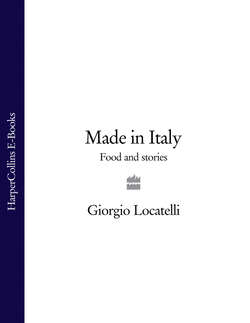Читать книгу Made in Italy: Food and Stories - Giorgio Locatelli - Страница 29
Acciughe Anchovies
Оглавление‘A fish that deserves respect’
Sometimes it seems to me that people in the UK don’t think of the anchovy as a fish at all, but as something in a category all of its own, that goes on top of pizza or into a salade niçoise. In Italy, though, we have a great respect for anchovies. The ancient Romans ate them fresh and it is thought that, together with sardines and mackerel, they also saturated them in salt and let them ferment in the sun, sometimes adding herbs and wine, to make a sauce called liquamen for seasoning food – rather like Thai fish sauce. In the North, they sometimes add anchovies to osso buco. In Sicilia, they like to cook them al beccafico – boned, sprinkled with a little vinegar, covered in breadcrumbs and herbs and grilled or baked. In Trentino-Alto Adige, they specialise in speck (the hind leg of the pig, cured in salt, pepper, juniper and bay, then smoked over wood and juniper berries), which they serve with anchovies mashed into butter. In the South, anchovies are used in a sauce for pasta.
When I was a child, at Christmas and on special occasions, such as my grandfather’s birthday, we used to have anchovies in salsa piccante (the only time I ever tasted chilli when I was growing up), which came in small gold tins decorated with three little dwarves, like the ones in Snow White, wearing yellow, red and green hats. They were made by a company called Rizzoli in Parma, who still produce them, in a sauce they have been making to a secret recipe for a hundred years. Whenever I go to Italy and see the gold tins in a delicatessen, I still can’t resist them.
Another thing I adore is dissolved or ‘melted’ (sciolte) anchovies. You put some anchovies into a pan with some olive oil, turn on the heat and warm gently to ‘melt’ the anchovies, rather than fry them, or they will lose their flavour. If you buy 500g salted anchovies, rinse off the salt, dry them, then ‘melt’ them like this; you can transfer the paste to a sterilised jar and cover it with a layer of olive oil. It will keep for six months in the fridge, so you can take it out and spoon some over pasta whenever you want. ‘Melted-down’ anchovies are the basis of the famous Piemonte autumn dish, bagna càôda, which literally means ‘warm bath’ (see page 146). Like so many Piemontese recipes, it is a dish that needs lots of people to gather round the table with a bottle of good Barolo and share big plates of vegetables, usually raw but sometimes boiled, which you dip into the bagna càôda. It is made with anchovies, garlic (soaked first in milk), oil and butter, and is kept warm in an earthenware pot over a spirit flame in the middle of the table. Sometimes, when only a little of the sauce is left, people break in some eggs and scramble them. Such a fantastic convivial thing to do.
It is a funny thing that Piemonte, one of the only regions of Italy that doesn’t touch the sea, has a dish based on anchovies as one of its specialities. The reason is historical. About 300 years ago, the Piemontese people harvested salt and made butter in the mountains. These were traded along the ancient salt routes in return for anchovies from Liguria. A traditional thing that many Piemonte bars do in the early evening is to put out little sandwiches made with butter and anchovies, which you can eat with a glass of wine. Even now, there are still associations of anciue (anchovy sellers) in and around the old trading town of Val Maira that hold dinners to celebrate the relationship between salt, anchovies and butter.
In British fish markets, you rarely find the blue-green and silver fresh anchovies. So you usually have to buy them either still on the bone and preserved in salt (the fish are layered with sea salt in small barrels), or filleted and preserved in olive oil. Frequently in the UK, though, the oil is cheap and tastes rancid, and if the fillets are in upright jars they are squashed in so tightly that the ones in the centre become mashed and broken (the fillets laid flat in tins are better), so I always prefer to buy the ones in salt. I have to admit that I buy Spanish ones, because the quality is so good. You have first to soak them in water to get rid of excess salt, then take out the bones and pat the fish dry. Then you can either marinate them in good olive oil, a little vinegar and some chopped herbs and serve them as part of an antipasti, or use them in whatever recipe you want.
